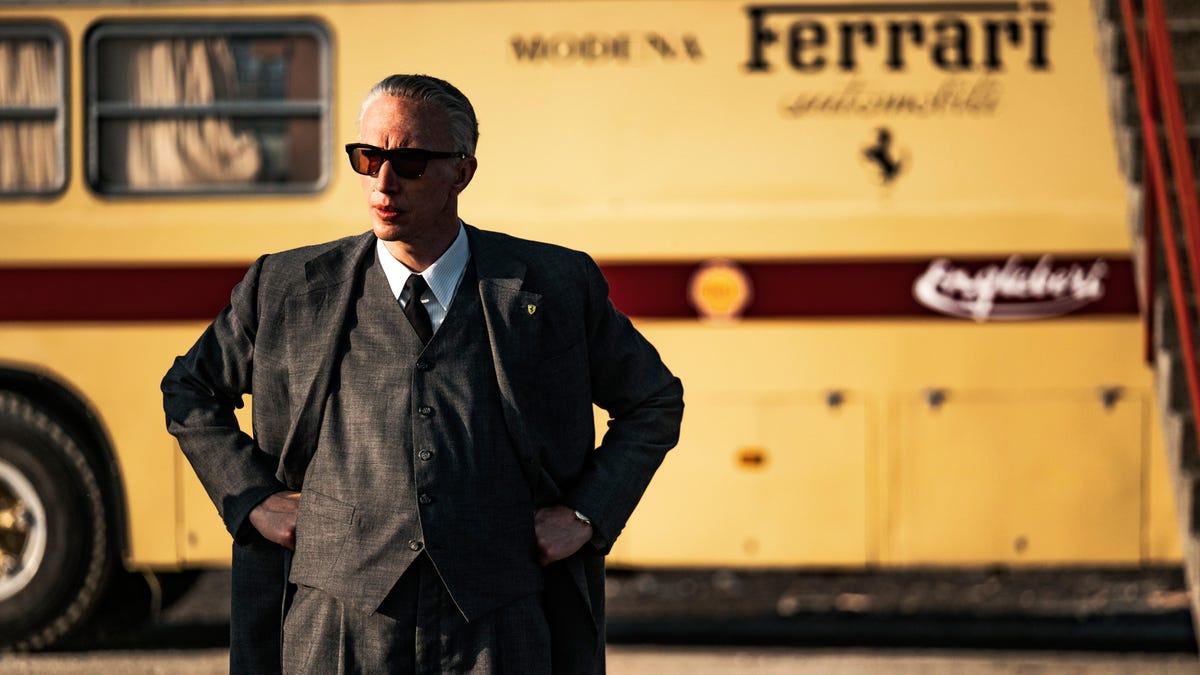With Ferrari, director Michael Mann pops the hood and takes a look at the engine powering one man’s journey towards icon status during a tumultuous time. Through this titular, fallible protagonist, the audacious auteur explores many of his favorite recurring themes about the male identity, ruminating on men’s specialized skillsets, strengths, and vulnerabilities—especially when it comes to relationships with women. He also adds a kinetic, combustible beauty within gripping action sequences that put us in the driver’s seat as we ogle that gloriously seductive signature racing red.
Michelle Yeoh brought her Oscar to her wedding
Once a preeminent race car driver, Enzo Ferrari (Adam Driver) is having a tough go of it as an entrepreneur in 1957. It’s been 10 years since he opened a factory in the rubble of post-war Italy with his wife Laura (Penélope Cruz), and their business manufacturing personal and professional sports cars is on the verge of collapse. Their marriage is also in shambles due to the recent death of their terminally ill 24-year-old son Dino (who’s incidentally named after Enzo’s deceased brother and father). Plus Enzo’s been leading a secretive second life with mistress Lina Lardi (Shailene Woodley) and their young son Piero (Giuseppe Festinese). His abrasive mother Adalgisa (Daniela Piperno) makes no secret about her judgment of him, cruelly uttering, “The wrong son died.”
Business manager Cuoghi (Giuseppe Bonifati) advises Enzo that if he doesn’t find an investor soon, he’ll be bankrupt. A partnership with another company would allow him to carry on his obsession with creating the perfect race car while manufacturing hundreds of consumer cars. However, he must take control of Laura’s shares in the business, as well as win the Mille Miglia—a treacherous, high-pressure, multi-driver race through the Italian countryside—to attract the capital in the first place. And even if he can, he’s reticent to cede any power to another corporation. Plus he’s breaking in a new headstrong driver, Alfonso De Portago (Gabriel Leone), and facing a battle with Laura, whose grief has turned corrosive.
Tooling around in the territory Mann and screenwriter Troy Kennedy Martin map out is deeply fascinating. The adaption of Brock Yates’ novel “Enzo Ferrari: The Man, The Cars, The Races, The Machine,” starts at a place of palpable loss that allows Enzo to experience a precision-calibrated ascension over the course of the picture. Strategic character construction reveals a dichotomous man chasing the myth of perfection in his professional career while his personal life is a sloppy mess of self-styled entanglements. The film takes a blessed reprieve from becoming a stereotypical hagiography, as the filmmakers spotlight their subject’s human frailty and foibles without romanticizing them, and also take a sharp left turn during the alarmingly visceral, gory climax that wraps up this package in a fittingly untidy bow.
There’s ample time to unpack our hero’s internal machinations, from the self-sabotaging of his company and personal life to the guilt and grief spawned by the deaths of his friends and family. Mann and company brilliantly dig into how this haunting sorrow affects his relationships with the living. Enzo puts up walls, often coldly treating interpersonal interactions like they’re engineering problems to be solved on one of his roaring beasts of the road, or looking at drivers as just another gear in the machine. And each of his relationships with the women in his life reflects a different struggle: With Lina he wrestles with his emotions. He battles with Laura about the business. And his conflict with his mother is focused on his ego. He tries to compartmentalize his anxieties and fears lest they all crash into one another.
Like Ferrari himself, the technical craftsmanship earns high marks. Erik Messerschmidt takes a painterly approach to capturing the three drastically different worlds Enzo inhabits. He tailors each for a nuanced mood—whether we’re in the soothing sanctuary of the Lardi home, between the walls of the dank and oppressive Ferrari chambers, or feeling the freedom of the airy race track. This all works in chorus with Maria Djurkovic’s perfect production design, with its distinct color palettes enhancing character texture, and Daniel Pemberton’s score, which is both symphonic and percussive, occasionally aided by compositions by Lisa Gerrard and Pieter Bourke.
Driver is terrific as Enzo, nailing the true-life figure’s tall stature and poised physicality, but also insightfully highlighting hidden facets in the character’s psyche. He’s a nimble performer in the choreographed dance between his pensive, internalized actions and Mann’s specialty of strong staging. Both performance and camera placement evoke an emotional response. Cruz turns in commanding work, practically stealing the film away from its lead. Though she’s played a happy-turned-disgruntled wife before, she fills in the lines of this cantankerous character with unique colors and shading. Woodley, a capable actress who’s miscast, is overshadowed, showing little compelling presence outside of narrative function.
The movie is often darkly funny as the characters lob barbs at each other. Nevertheless, the story feels a tad truncated in spots. An elongated run time would service the action and narrative a bit better—and, as Mann fans know, he does love releasing a good director’s cut. It’s also not quite the ensemble piece audiences might expect from him with its solid roster of supporting actors (for example, Patrick Dempsey as Ferrari’s racing driver Piero Taruffi is surprisingly underserviced). However, when it comes to its thematic pull, Ferrari belongs in the same showroom as the rest of Mann’s filmography.
Ferrari opens in theaters on December 25
